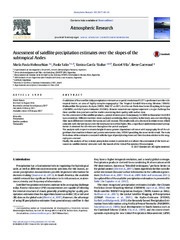Mostrar el registro sencillo del ítem
Assessment of satellite precipitation estimates over the slopes of the subtropical Andes
| dc.contributor.author | Hobouchian, María Paula | |
| dc.contributor.author | Salio, Paola | |
| dc.contributor.author | García Skabar, Yanina | |
| dc.contributor.author | Vila, Daniel | |
| dc.contributor.author | Garreaud, Rene | |
| dc.date.accessioned | 2017-03-06T18:47:46Z | |
| dc.date.available | 2017-03-06T18:47:46Z | |
| dc.date.issued | 2017-02-16 | |
| dc.identifier.uri | http://hdl.handle.net/20.500.12160/144 | |
| dc.identifier.uri | http://www.sciencedirect.com/science/article/pii/S0169809516302423 | en |
| dc.identifier.uri | http://dx.doi.org/10.1016/j.atmosres.2017.02.006 | en |
| dc.description | Artículo publicado en la Revista Atmospheric Research, Volumen 190, 1 Julio 2017, páginas 43-54. | es |
| dc.description.abstract | A validation of four satellite daily precipitation estimates at a spatial resolution of 0.25° is performed over the subtropical Andes, an area of highly complex topography: The Tropical Rainfall Measuring Mission (TRMM) Multisatellite Precipitation Analysis (TMPA, 3B42 V7 and RT), the Climate Prediction Center Morphing technique (CMORPH) and the Hydro-Estimator (HYDRO). Remote mountainous regions represent a major challenge for these satellite data products and for studies examining their quality with surface data. For the assessment of the satellite products, a period of seven years from January 1st 2004 to December 31st 2010 was considered. Different statistics were analyzed considering their variability in the study area and identifying their main differences between the warm and cold seasons. The results indicate a decrease in winter errors which coincides with the wet season over the windward side of the Andes. Also, a significant underestimation of precipitation is observed for all estimates throughout the period analyzed. The analysis with respect to terrain height shows a greater dependence of errors with topography for all the algorithms that combine infrared and passive microwave data, HYDRO providing the most stable result. The main limitations of the estimates associated with the type of precipitating event and their location relative to the orography are assessed. Finally, the analysis of two intense precipitation events is presented and allows the assessment of the latest advances in satellite derived estimates with the launch of the Global Precipitation Measurement. | en |
| dc.language.iso | eng | es |
| dc.publisher | Elsevier | es |
| dc.subject | PRECIPITATION | es |
| dc.subject | SATELLITE PRODUCTS | es |
| dc.subject | TOPOGRAPHY | es |
| dc.subject | PRECIPITACION | es |
| dc.subject | SATELITE | es |
| dc.subject | TOPOGRAFÍA | es |
| dc.title | Assessment of satellite precipitation estimates over the slopes of the subtropical Andes | es |
| dc.type | Article | es |
